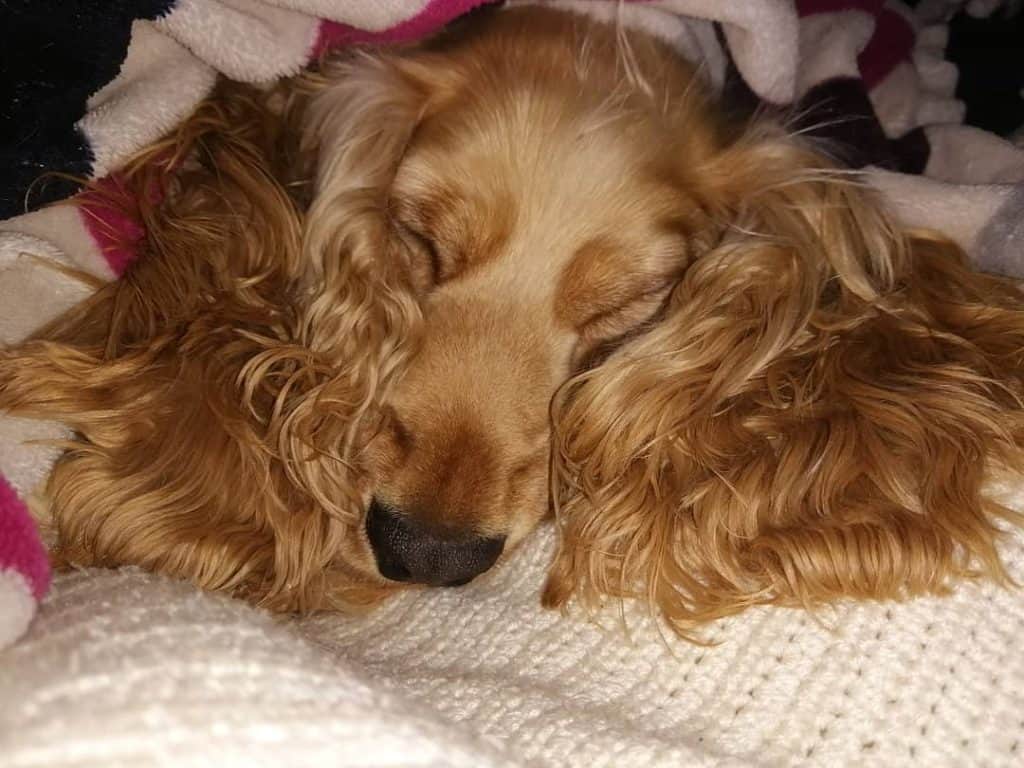One of the most critical decisions a dog owner can make is where their dog sleeps at night. I grew up in a dog-loving family where dogs slept inside on our beds. But, not everyone agreed that this is a good option. It all depends on the dog and the owner.
Your dog will be thrilled to sleep either indoors or outdoors. It depends on you and your dog’s individual needs. Some people like to cuddle up next to their furry friends, while others prefer dogs to remain outside. There is no right or wrong answer here.

What Do You Want?
First of all, what fits into your lifestyle best? Once you can answer that question, the rest is almost self-explanatory. You see, it doesn’t matter what anyone else says. As long as you meet all of your dog’s needs, you’re good to go.
Every person’s relationship with their dog differs
Ultimately, so will their needs. Some people prefer to have dogs around their feet every second of the day. They like constant companionship. Others might like their dogs to keep busy in the yard while finding solitude inside the house. So ask yourself some questions:
Do you like a dog inside the house when you sleep? Do you want a constant companion inside the house? Did you get your dog to have continuous company? Then, you might consider letting your dog sleep inside.
On the other hand, do you like a house with as little dog hair as possible? Do you have a large enough yard for your dog to roam free? Do you have other animals or small children inside the house that need supervision around your dogs? Do you prefer your indoor space to be clean and stress-free? Then, you might consider letting your dog sleep outside.
Just Remember to Meet Your Dog’s Needs
So, as you can see, it’s ultimately up to you, the owner. Just remember that whichever you choose, you need to meet all of your dog’s needs. These needs include:
- Shelter from all weather conditions
- A fresh bowl of water to drink
- Space to roam
- An area to relieve themselves
- A comfortable place to sleep
- Proper fencing to prevent escape (please never chain your dog!)
- Low to no risk of self-injury
What Does Your Dog Want?
Dogs also have preferences of where they want to sleep. They might have something different in mind, whether you’d like them inside or outside. So, it would help if you observe your dog to see where they acclimate best.
For example, Dixie (my female Cocker Spaniel) usually likes to cuddle beside me on the bed, but she prefers to sleep outside when it’s hot. This is heartbreaking because I value her little body next to mine at night. But, I know that this is where she feels more comfortable, so I let her decide.
Considering Your Dog’s Choice
Some people may argue that giving the dog the choice means you’re not the leader of your dog. But I’m afraid I have to disagree. I believe that considering your dog’s preferences means they are more comfortable in the environment you put them in.

The Leadership Role
Being a good leader means that you have to give your dog some freedom of choice. Yes, there should always be healthy boundaries of where they can and cannot go. But taking a dog’s choice away also means you’re not allowing them to figure things out for themselves.
If you’re worried about your leadership, check out these training tips to humanely improve your leadership over your dog.
Combining Your and Your Dog’s Preferences
Remember that a dog’s preference might not always be practical in your household. For instance, if your dog wants to sleep outside, but your only outdoor space is a balcony on the 7th floor, it might not be such a good idea. So, keep practicality in mind when you observe your dog’s preferences.
If you combine what you want and your dog’s preference, you can develop a good sleeping arrangement that suits you both. Here are some examples:
| What You Want | Your Dog’s Preference | A Suggested Solution |
| For your dog to sleep inside on your bed | To sleep inside on your bed | Let your dog sleep in your bed |
| For your dog to sleep inside, but not on the bed | To sleep inside on your bed | Put a dog bed next to you your bed |
| For your dog to sleep inside on your bed | To sleep inside, but not on your bed | Put a dog bed next to your bed or any other area in the house where they’re comfortable. |
| For your dog to sleep inside, but not on the bed | To sleep inside, but not on your bed | Put a dog bed next to your bed or any other area in the house where they’re comfortable. |
| For your dog to sleep inside | To sleep outside | Consider if your dog can safely sleep outside. If not, consider putting a dog bed close to a window or door. |
| For your dog to sleep outside | To sleep outside | Give your dog a safe space to sleep outside |
| For your dog to sleep outside | To sleep outside | Consider slowly getting your dog used to sleeping outside |
Remember, if you and your dog are happy and safe, you do the right thing.
The Pros and Cons of a Dog Sleeping Inside
WebMD says that “sleeping with pets isn’t unusual in this country. According to a recent survey of pet owners by the American Pet Products Association, nearly half of dogs sleep in their owner’s beds.” The survey found that 62% of small dogs, 41% of medium-sized dogs, and 32% of large dogs sleep with their owners.
But like most things in life, there are pros and cons to your dog sleeping inside the house at night. If you’re still unsure which to choose, use these pros and cons to help you decide.
The Pros and Cons of a Dog Sleeping Inside (on the Bed or Not)
| Pros | Cons |
| Safety from potential intruders | Your dog can mess inside the house if they don’t have access outside or wake you if they need to go. |
The Pros and Cons of a Dog Sleeping On Your Bed
| Pros | Cons |
| Extra warmth when it gets cold | Your dog might keep you from getting a good night’s sleep |
| Creates an increased bond between dog and owner | Your dog might bring dirt, bacteria, or other hygiene issues to your bed |
| Companionship and a sense of security, especially for children | It might cause dominance issues (although it’s not definite) |
What to Keep in Mind When Your Dog Sleeps Inside
If you want your dog to sleep inside, do you want them inside your bed or not? Here’s what you need to keep in mind whether you want your dog in their bed indoors or with you on the bed at night:
When Your Dog Sleeps On Your Bed
You can try to limit the cons by ensuring you set the rules for your dog to cuddle up next to you at night.
• Only allow your dog on the bed when you’ve invited them
• Don’t allow your dog on the bed if they’re aggressive or mouthy
• Select a designated spot on the bed where your dog is permitted to sleep
• Be careful not to let your dog dictate where you can lie down. It’s your bed, and you make the rules.
• Ensure that your dog has good hygiene to prevent ticks or fleas from entering your bed.
• Be sure to let your dog relieve themselves before going to bed.
When Your Dog Sleeps On Their Own Bed Indoors
You can limit the cons by ensuring you set the rules for your dog to sleep indoors.
• Teach your dog where they’re allowed to sleep. You can do this by having a designated dog bed or crate where they feel safe.
• Ensure your dog relieve themselves before they go to bed.
• Ensure that your dog is comfortable where they sleep with access to fresh drinking water.
The Pros and Cons of a Dog Sleeping Outside
It’s lovely if you want your dog to sleep outside. Just remember that they should be safe at all times. If you’re still not sure where your dog should sleep, here’s a list of the pros and cons of a dog sleeping outside.
| Pros | Cons |
| Your house won’t be a mess because of your dog | Weather changes can be harsh on your dog’s body |
| There is no dominance issue resulting from sleeping arrangements | The great outdoors poses many potential hazards |
| Decreased allergy and health risks for the humans in the house | Your dog can become bored and lonely |
What to Keep in Mind When Your Dog Sleeps Outside
If you want your dog to sleep outside, you should ensure that you meet all their needs. These include their safety and protection and their mental and physical needs. The Daily Puppy gives some good advice on keeping your dog outside all year round while keeping them safe and happy.

Provide shelter from extreme temperatures
When you get a dog house or some shelter, ensure that it is insulated. It will help keep extreme heat or cold outside, and your dog will be more comfortable in these extreme temperatures.
Protect Your Dog from Wind and Rain
The shelter shouldn’t let wind and rain get to your dog. So, place the dog house where they’ll keep warm and dry even if the wind picks up. Also, try to see if the dog house leaks when it rains. Fixing a weak spot will ensure your dog doesn’t get wet when trying to hide from the rain.
With Extreme Weather Conditions, Bring Your Dog Inside
Some countries get severe rainstorms, blizzards, snow, or heat waves. In these cases, always bring your dog inside. I always recommend that dog owners try to stand outside with bare feet to figure out if it is okay for their dogs to be out. If you can’t stand the heat or cold, neither can your dog.
Prevent Loneliness
Dogs are social creatures and need daily interaction with their owners and fellow animals. Some dogs can cope well on their own with only daily interaction with people. But, other dogs need a furry companion as well.
Either way, you need to play with your dog in the yard, go jogging, or play in the park every day of the week, especially if you want them to be outside most of the day. If you don’t, they might get bored and become destructive.
Provide Fresh Food and Water
It would help if you kept a close eye on your dog’s food and water supplies when they live outside. I recommend keeping a feeding schedule, so you don’t leave food out all day. It can lure insects or bacteria that can make your dog ill.
Your dog also needs fresh drinking water every day. So, fill a bowl they won’t tip over easily with fresh water daily. If you don’t replace the water regularly, bacteria and fungus can grow inside the bowl, and your dog can get sick.
Keep Your Dog Safe from Potential Hazards
A dog living outside faces more hazards or dangerous situations than dogs sleeping inside. So, ensure that you make your dog’s outside environment as safe as possible. For instance:
• Ensure that there are no toxic plants your dog can get hold of
• Ensure that your dog can’t escape your yard by adding proper fencing
• Ensure no wild animals can enter your yard. They can harm your dog or carry diseases onto your property.
• Inspect your dog’s body daily to ensure they don’t get hurt or sick. If you suspect your dog was injured or ill, take them to your local vet immediately.
The Paws Perspective
I prefer to let my two cocker spaniels sleep in my bed with my husband and me. It gets crowded, but we love the companionship and affection.
Some nights, Dixie sleeps in the living room or outside, especially when it gets hot. On the other hand, Joey (our male cocker spaniel) likes to cuddle regardless of temperature.
I always invite them to climb on the bed, and they’re not allowed on the bed when we’re not there.
We initially had a bit of a dominance issue with Joey, but I realized that’s because we let him sleep on our pillows. Some dog behaviorists believe that a dog shouldn’t be higher than the owner, and I found that to be true with Joey, but not with Dixie.
So, we moved him lower than our heads and gave him a designated spot at our feet. Now, the dominance issue disappeared, and we all slept happily ever after!

